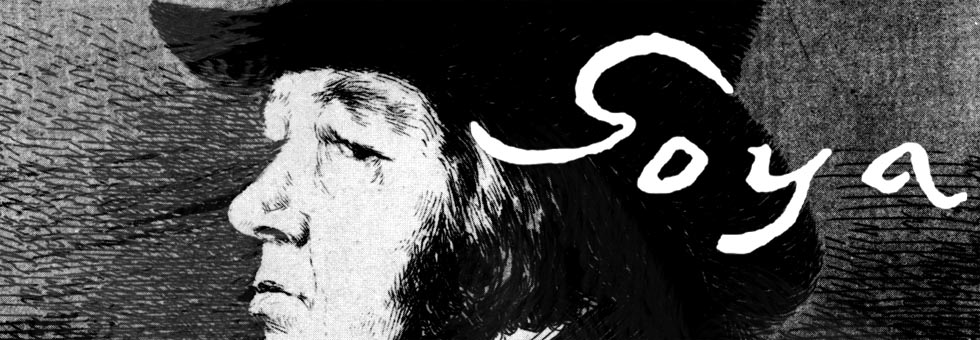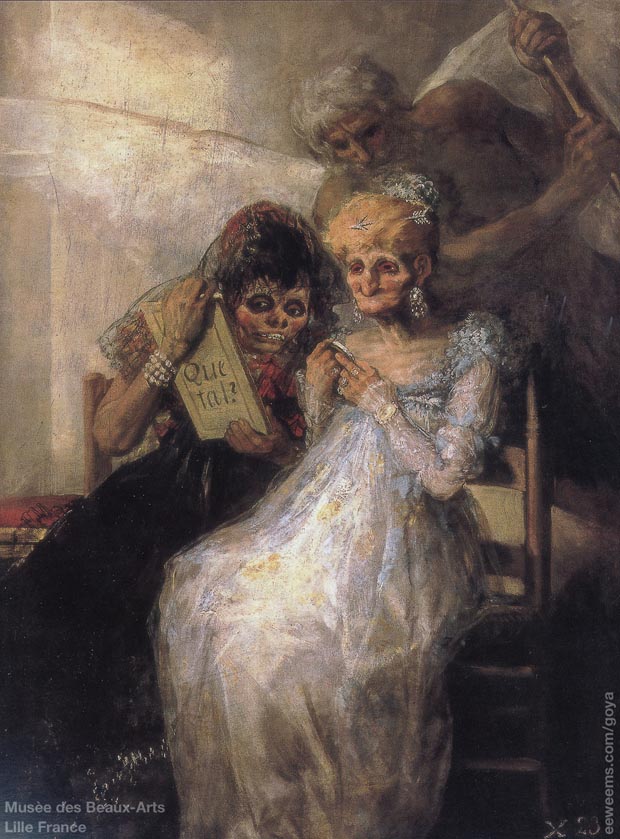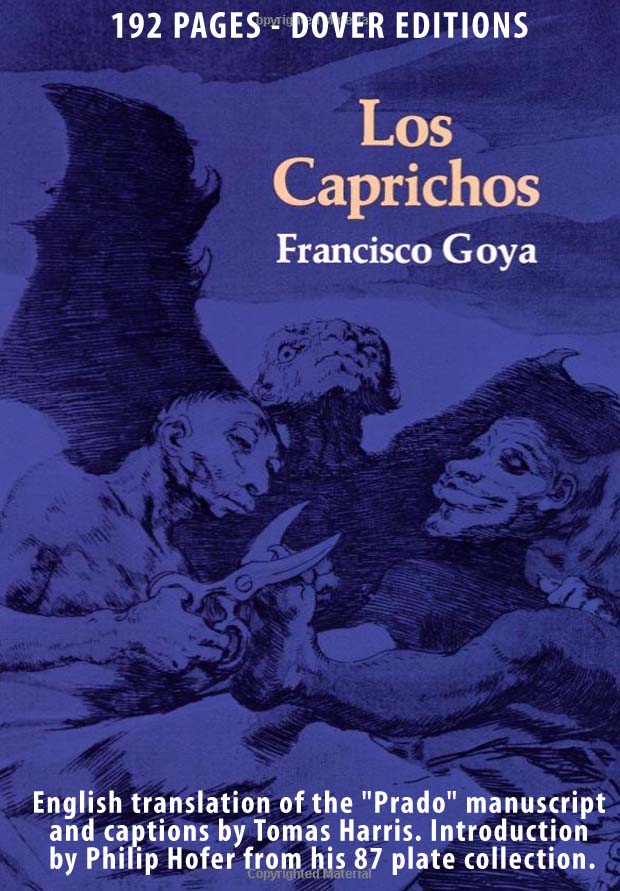Goya | Time - Las viejas
Time
Las viejas
Also sometimes called:
The Old Girls
The Old Ones
Time and the Old Women
Old Women looking in a Mirror
Que Tal? ("How goes it?")
1810-1812 Oil on linen
181 cm x 125 cm
Musèe des Beaux-Arts, Lille France
This painting is at the Musèe des Beaux-Arts in Lille France also see this page at webmuseo.com [in French]
There isn't any evidence that Goya kept an official record of his work to provide a strict chronology of his production. In fact, there is not any specific way to know in particular what he meant in many of his paintings. An example of this dilemma is this image, las viejas, called by so many various titles by art scholars over the years that a sure meaning seems simple enough yet produces new titles as interpretations are made.
What do these two old women hold in their hands which they peer at with such intensity? Fred Licht says it is a "scandal journal," but most art writers say it is a mirror. These two are about to be swept away by the figure behind them, and so we look at what is the editorial meaning contained in the Spanish of ¿Que Tal? ("How are things?" or "What's the news?") written on the reverse of the gripped object (in which we might surmise the question "Que tal?" and then answer "not good.")
Goya was approximately 65 years old when he painted this image, a veteran of various life-threatening illnesses which had left him deaf (1792) and would eventually kill him (1828). Thus the painting is hardly the laughter of a robust young man pointing a finger at the silly activities of a doddering pair of ladies, but instead this painting shows the thoughts of an old one simultaneously obsessing on mortality and excoriating the foolishness and vanity of his own older age group. These two old women, disintegrating beneath masks of youthful makeup and clothing, are not running in terror from the mystical being* bearing down upon them because they simply do not know what's coming – but Goya does.
"...although Goya ceased to paint popular subjects as cartoons for tapestries after about 1790, he continued from time to time to paint distinct groups of pictures of the everyday. Occasionally these suggest that some grander decorative scheme may have been projected. The Water Carrier, usually dated to between 1808 and 1812, and its small companion The Knife Grinder are connected both stylistically and in conception with the very large canvas The Forge. Much darker than his earlier tapestry designs, these present heroically-posed close-ups of workers. Their paint fracture is redolent of the forceful, broad handling of his earlier San Antonio frescoes, Goya using a palette knife to apply rich blacks and others. Possibly related to this series are Old Women Looking at a Mirror and Young Women reading a Letter, which are both substantial canvases, but are satires on vanity rather than celebrations of worker-heroes, and seem in essence to be larger versions of subjects dealt with in the earlier Caprichos."
Frank Milner, Goya, published 1995 by the Bison Group, page 22.
"...In The Old Ones we again encounter mistress and servant – this time in a frightfully decayed state. Syphilis has corrupted the face of the maid into a hideously deformed snout, while the mistress, haggard and toothless but rouged and coiffed in the latest fashion, looks on with rheumy eyes as page after page of a scandal journal is turned for her amusement by her companion. Behind the two women, a winged old man wields a broom aloft, ready to sweep this human offal away."
Fred Licht, Goya, published by Abbeville Press, Pages 268 - 269
"A pair of crones are examining, if not exactly admiring, themselves in a hand mirror. On the back is the sardonic inscription ¿Que´ tal? ("How's things?"). No good, it seems. The old bat on the right, a chapfallen dame in a beautifully light-struck muslin robe of pale blue and yellow, fiddles with what appears to be a powder compact; in her dyed-blond hair is a jeweled arrow, of the kind that Queen Maria Luisa was wearing in the Family of Charles IV. (This similarity gave rise to the idea that she is Goya's horrid caricature of Maria Luisa herself, but there seems to be no real basis for that. Diamante arrows were a common kind of hairpin.) Artifacts last; their owners decay. Her companion is a horror, a death's head, her nose eaten away by the pox, her hands like claws, her lips and eyes raddled with caked incrustations of lipstick and kohl, her teeth discolored. Rising behind them, also peering at their reflected images, is the ultimate victor of this colloquy: Father Time, with his shag of gray hair and extended wings, grasping not a scythe but a broom with which he will sweep the crones away like the dust they are so nearly are."
Robert Hughes, Goya, published by Alfred Knopf, page 348.
*A question regarding the being with the broom is that it is most usually identified as "Father Time," or simply "Time." Typically, Time in imagery over the centuries is often equipped with wings and a scythe, and yet Goya has not followed this imagery standard that dates to the Romans and Greeks, but instead has given his winged creature a broom.
AMAZON
Goya The Terrible Sublime - Graphic Novel - (Spanish Edition) - Amazon
"From this headlong seizure of life we should not expect a calm and refined art, nor a reflective one. Yet Goya was more than a Nietzschean egoist riding roughshod over the world to assert his supermanhood. He was receptive to all shades of feeling, and it was his extreme sensitivity as well as his muscular temerity that actuated his assaults on the outrageous society of Spain." From Thomas Craven's essay on Goya from MEN OF ART (1931).
"...Loneliness has its limits, for Goya was not a prophet but a painter. If he had not been a painter his attitude to life would have found expression only in preaching or suicide." From Andre Malroux's essay in SATURN: AN ESSAY ON GOYA (1957).
"Goya is always a great artist, often a frightening one...light and shade play upon atrocious horrors." From Charles Baudelaire's essay on Goya from CURIOSITES ESTRANGERS (1842).
"[An] extraordinary mingling of hatred and compassion, despair and sardonic humour, realism and fantasy." From the foreword by Aldous Huxley to THE COMPLETE ETCHINGS OF GOYA (1962).
"His analysis in paint, chalk and ink of mass disaster and human frailty pointed to someone obsessed with the chaos of existence..." From the book on Goya by Sarah Symmons (1998).
"I cannot forgive you for admiring Goya...I find nothing in the least pleasing about his paintings or his etchings..." From a letter to (spanish) Duchess Colonna from the French writer Prosper Merimee (1869).
GOYA : Los Caprichos - Dover Edition - Amazon





